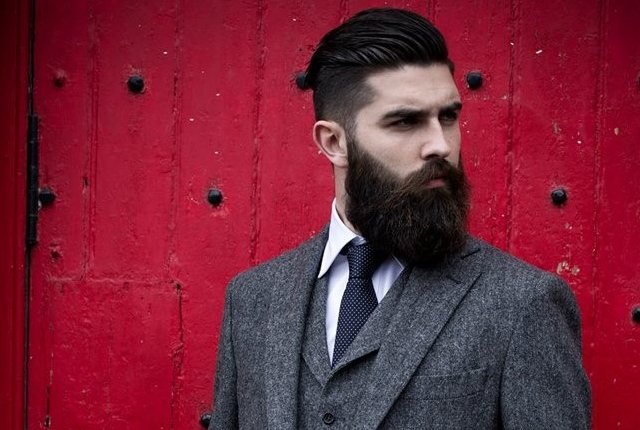A century or so after the handlebar mustache made boardrooms look like a convention of Kaiser Wilhelm II impersonators, facial hair has found its way back to the professional setting.
As a new generation of men rises into positions of power in the workplace — helping to relax standards for what constitutes executive style — beards and even Hercule Poirot-esque waxed mustaches are becoming more common in the office.
The secret to pulling off this look, according to barbers and style consultants for businessmen, is striking the right balance of hair and common sense. That means understanding one’s industry and taking into account one’s age, general appearance — and physical limitations.
“Facial hair can look great, but it has to suit the right person,” said Brent Pankhurst, owner of the Pankhurst salon in London’s Mayfair neighborhood. (It offers haircuts in the style of Steve McQueen, for the tousled tough-guy effect, and Montgomery Clift, for the more classically handsome.) And there’s a facial hair approach à la Michael Fassbender (stubble) or Ryan Gosling (medium length).
“A good barber takes into consideration how a guy looks when he walks through the door, what’s he interested in, and then makes him look as good as he can and gives him something he can manage,” Mr. Pankhurst said during an interview in his über-masculine salon.
In the booming industry of upscale men’s grooming, facial hair is like any other element of executive style. From a simple evaluation in a barber’s chair — Mr. Pankhurst’s chairs are designed by Bentley, with the same leather and cross-stitching as the company’s car seats — to a session with a consultant who dresses professionals and advises on facial hair, fingernail length, what-have-you, the aim is to find what works best for the individual in an environment where individualism may not always be celebrated.
“For example, the fisherman’s beard is a trend, but it will go out of fashion,” Mr. Pankhurst said, referring to the moppy, bunchy beards that can grow inches below the chin. “People will look back on photographs in 10 years and ask, ‘What the hell was I thinking?”’ he said. “Anything longer than a medium-length beard is a no-no for the boardroom.”
Of course, the workplace and the company’s style help determine what’s acceptable. For Joseph Rosenfeld, a personal brand and style strategist in San Jose, Calif., the hipster look of the Silicon Valley executive, combined with the nerd factor, has changed the approach to facial hair in the last decade or so, as the goatee went from an innovation to a trend to almost a cliché.
“When you’re dealing with a base of engineers who create all the different products and solutions in this area, it’s pretty acceptable for guys to wear facial hair in all different configurations,” Mr. Rosenfeld, 45, said in a phone interview. “But you have to be very careful because of the messages that could be conveyed by a beard that looks incomplete or not fully grown. It can be incongruous with a guy who gets the job done.”
Mr. Rosenfeld also sees facial hair as more than just a fashion statement or even something beyond an expression of masculinity or sexuality — especially in the workplace. It can help some workers feel more comfortable.
“Facial hair might give someone a cover if he’s more introverted, or he can grow a beard to put on a better face if, for example, he has pockmarks,” he said. “It’s no different than a woman putting on makeup.”
But especially in the start-up and tech world, many people have become executives at a young age — and with it attendant wealth and self-importance, Mr. Rosenfeld said.
“There’s a bit of ego at that level that they want to do what they want to do,” Mr. Rosenfeld said, citing Mark Zuckerberg’s fondness for wearing hoodies to Facebook’s board meetings and corporate events.
A prototype of the tech wunderkind is Lawrence J. Ellison, who founded the software company Oracle in 1977 and now, at age 70, is one of the world’s richest people. He has long sported some sort of beard-mustache combination.
“Larry Ellison of Oracle has facial hair, but it can look at little rough, like sandpaper on him, and he could be perceived as being abrasive to some,” Mr. Rosenfeld said. “I’m concerned about that kind of thing when I work with my clients.”
Mr. Ellison, through a spokeswoman, declined to comment.
As with any business, discovering what works best for the client involves a continuous quest. At the Ottoman Crew in the Bloomsbury neighborhood of London, the 18-year-old owner, Hasan Yaman, manages a group of young barbers. Many display their own styles of facial hair, in a sort of self-experimentation as they cater to ever-changing customer whims.
“About six or seven years ago most young guys wanted a slim jawline cut and, over the lips, something more detailed and more sharp,” Mr. Yaman said. “Now they’re going for a more natural look.” But, he cautions, “when it’s too natural, it’s a bit scruffy and out of hand.”
His old-style Turkish barbershop, complete with lavish gold-trimmed mirrors and sparkling chandeliers above rust-colored leather chairs, is at once cozy and spiffy. The barbers wear red-trimmed vests and serve Turkish tea. Mr. Yaman said it’s all part of the mood for the repeat customer, many of whom come in every couple of weeks for a tune-up, especially executives who want to maintain a consistent and clean look.
“With hair, you can really fix it up, but a beard is more stubborn, so it takes a bit of time and effort. When you comb it down, you still get bits sticking out,” he said. “Mustaches are becoming more trendy now, and I’m even seeing guys curling them up.”
The amount of care and use of “product” previously restricted to hair grooming is now often devoted to facial preening, Mr. Yaman said. “They’re twisting their mustaches and rubbing their beards instead of running their hands through their hair.”
Too fussy, though, is too much, according to Mr. Pankhurst, the Mayfair barber. “The most important thing is not to have hard, clean lines,” he said. “You should always leave it as natural as possible.”
Continue reading the main storyContinue reading the main storyContinue reading the main story
That is the aim of one of the Pankhurst patrons, Daniel Millar. Mr. Millar, 37, owns a Dubai-based commodities trading firm, Ferrocadia, but has his barbering done back in his native London whenever possible.
“In Dubai, with the locals you see a lot of beard-staches and lots of laser hair removal so that they have these perfect lines on their beards,” Mr. Millar said. “I always just leave a bit of stubble. I don’t like the long-bearded look. I don’t think that fits with board meetings.”
Another Pankhurst regular is Clive Darby, 48, a fashion and luxury consultant, who owns CD Consultancy in London.
“I dip in and out of going heavy on the beard, and I think the perception of facial hair today has changed so dramatically,” Mr. Darby said during a recent interview over drinks in the guyishly swanky Map Room at Claridge’s Hotel. “Men have all those metrosexual things and, just like for the ladies, these become security blankets. You like to put them on and you like to feel good and smell good. Men actually sit around a table and say, ‘By the way, you’re hair is looking great’ or ‘I really like your beard.’
“That would have never happened in my father’s era.”

